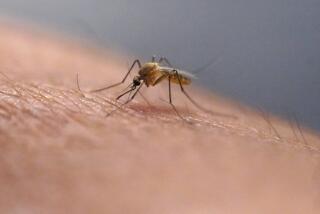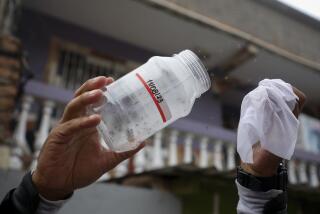Paraguayans fume over dengue outbreak
- Share via
ASUNCION, PARAGUAY — An outbreak of dengue fever linked to a hot, wet South American summer has prompted charges here of a botched government response and spurred fear that the disease is spreading to neighboring countries.
More than 18,000 people in Paraguay have contracted the mosquito-borne ailment, with at least a dozen fatalities, according to government statistics in this landlocked nation of 6.5 million.
An elevated incidence of dengue also has been reported in neighboring Brazil and Bolivia.
An Argentine health official who visited Asuncion blamed the problem in part on global warming and the resulting “tropicalization” of the continent. Authorities in adjacent nations have stepped up fumigation of vehicles and cargo along the Paraguayan frontier.
The official number of dengue cases in Paraguay is widely viewed here as an underestimation of the outbreak’s extent. Most of those infected are poor and their illness is never diagnosed, doctors say.
Some medical experts have said the number of cases could be as much as 10 times the official figure, or close to 200,000.
“The government wanted to cover up the problem without admitting the error it committed,” said Desiree Masi, who heads a physicians group critical of the official response.
President Nicanor Duarte Frutos, widely accused of reacting late and inadequately, has stepped up fumigation and other measures in recent weeks, and affirmed his determination to battle the disease. The president this month declared a 60-day state of emergency.
Dengue prevention efforts focus on fumigation and removing stagnant pools of water. Plastic containers, buckets, vases and discarded tires are classic mosquito reproduction sites.
Health Minister Oscar Martinez Doldan has resisted calls to resign and said recently that the outbreak had been controlled by an expanded effort to exterminate mosquitoes and get rid of their breeding grounds. Critics say the measures come too late and long after the first cases were reported.
The revelation that expired chemicals had been used in fumigation aimed at reducing dengue and malaria resulted in the sacking of Humberto Recalde, the Health Ministry official previously charged with overseeing the effort.
The government’s response to the crisis has dismayed many Paraguayans.
“This was an avoidable problem that spread, thanks to a lack of planning, which is something that characterizes this government,” said Maria Jose Garcia, 23, expressing the frustrations of many interviewed in Asuncion, the capital.
This largely tropical nation has experienced other dengue fever scares, but the death toll this time is higher than during a 2001-02 outbreak.
Experts have attributed the deaths in part to the appearance of more severe forms of the disease, including so-called hemorrhagic dengue, which can lead to bleeding and circulatory collapse.
Dengue fever, caused by one of four closely related viruses transmitted by infected mosquitoes, is a flulike illness that is seldom fatal. Symptoms include fever, chills, headaches, muscle and joint pain, nausea and general malaise.
There is no vaccine for dengue, which is now endemic to much of the world’s tropical regions. It cannot be spread from person to person.
The dengue outbreak in Paraguay is concentrated in the rain-drenched capital. Curbing dengue also requires a behavior shift, officials say, such as recognizing the danger of stagnant pools of water around homes where mosquitoes can lay eggs.
“There is a certain idleness and apathy on the part of the population when it comes to combating dengue,” said Masi, president of the Paraguayan Society of Doctors. “Local officials cannot keep saying that they don’t have the budget to maintain the campaign against dengue.”
Experts and donated equipment have arrived from abroad in recent weeks. Physicians agree that the outbreak here and elsewhere is related to unusually warm and damp weather, which has caused widespread flooding and favored the breeding of the Aedes aegypti mosquito, which spreads the disease.
“The problem of dengue is by no means solely an issue in Paraguay,” Andres Leibovich, Argentina’s undersecretary for health, said during a visit to Asuncion aimed at providing technical assistance.
The Argentine official linked the problem to South America’s “tropicalization” as temperatures rise, though the role of global warming remains theoretical. Even in Buenos Aires, the temperate Argentine capital, a mosquito infestation after recent downpours led to alerts about the possible spread of the disease.
Brazil is also suffering a dengue outbreak, with about 85,000 cases reported, authorities say. Dengue cases in Brazil rose almost 30% during January and February, the height of the Southern Hemisphere’s summer, compared with the same period last year, officials said.
The current dengue hot spot in Brazil is the southwestern state of Mato Grosso do Sul, which accounts for about half the nation’s cases, according to the Brazilian Ministry of Health. The state borders Paraguay, but Brazilian authorities say the cases are not linked to the Paraguayan outbreak.
Brazilian authorities are keen to reduce dengue in Rio de Janeiro before the Pan American Games begin there in July, which will be winter there. Officials hope cooler weather will help, as mosquitoes thrive in heat.
*
Special correspondent Amarilla reported from Asuncion and Times staff writer McDonnell from Buenos Aires. Special correspondent Marcelo Soares in Sao Paulo, Brazil, and Andres D’Alessandro of The Times’ Buenos Aires Bureau contributed to this report.
*
Begin text of infobox
Dengue fever facts
Cause
Four related viruses carried by mosquitoes, which become infected when they bite humans already infected.
Locations
During and shortly after rainy season in tropical and subtropical areas of Africa, Southeast Asia, China, India, the Middle East, the Caribbean, Central and South America, Australia and the South and Central Pacific.
Cases
More than 100 million worldwide each year. There is no vaccine.
Symptoms
Within five days of infection, a fever as high as 105 degrees, followed by severe headache, severe joint and muscle pain, nausea and vomiting, and rash. The disease is rarely fatal unless it advances to a hemorrhagic fever, which can be accompanied by massive bleeding and shock.
Diagnosis
Two blood tests, two to three weeks apart, show whether antibodies are present.
Treatment
Bed rest, drinking fluids and taking fever-reduction medicine. Recovery generally within two weeks.
Prevention
Control mosquitoes’ access to humans and eliminate areas where the insects breed.
*
Sources: National Institute of Allergy and Infectious Diseases, Times staff reports
More to Read
Sign up for Essential California
The most important California stories and recommendations in your inbox every morning.
You may occasionally receive promotional content from the Los Angeles Times.













